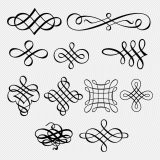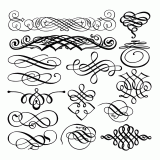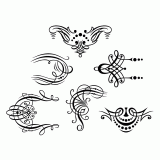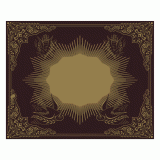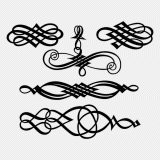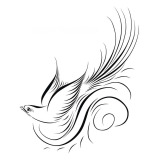The vector flourishes offered here have all been created by hand-tracing of outlines of flourishes found in some old books.
All the flourishes are colored black, so that you can simply adjust their size and use them straight away; it is, however, possible to change the color to your liking by editing it in an appropriate software. These vector flourishes are suitable for use in graphic designs and, one might say, they are ideal for wood carving.
The term ‘flourish’ implies embellishment of letters and text, as well as stand-alone decorative elements. Decorative flourishes were almost inevitable decoration of books and documents for centuries. Flourishes, that are considered a combination of drawing and calligraphy, presumably evolved during a long period of time from extended curved letter strokes executed for embellishment in calligraphy and penmanship, when beauty was an imperative in handwriting. Decorative flourishes, also known as calligraphic ornaments or ornate pictorial calligraphy, developed during centuries of writing and decorating of manuscripts. In Europe, flourishing was widely employed for the embellishment of English and German manuscripts.
In hand-written official documents from that time, flourished capital letters, as well as flourishes above and below the text and at the end of every written line, were rendered as decoration but also served to prevent additional writing to the text. Initially, flourishes were attached to the letters and served as letter decoration, but soon they became stand-alone ornaments, often positioned around the text and between the paragraphs and chapters of the manuscript. Over time, some penmen began to perform intricate flourishes as the main subject of their artwork.
Flourishes consist of combined lines, curves, spirals and loops, usually in form of a single, uninterrupted line executed by a quick but graceful movement of the pen. Thin and thick strokes at the same flourish are achieved by alternating low and high pressure of the pen, but never by tracing the same line more than once.
On this page we present and offer to download a beautiful collection of ornamental flourishes from the 17th century.
On this page you can download 15 decorative flourishes that we have drawn on the basis of illustrations found in the old books. In the pictures below you can see all the flourishes that are found in this collection.
On this page you can download a collection that contains 6 Flourish ornaments suitable for various decorating techniques.
We have found this pattern on the cover of the book “Real pen work: self-instructor in penmanship” (published 1881).
On this page you can download calligraphic flourishes that are nearly 500 hundred years old.
Here you can download a hand-traced vector pattern of a calligraphy bird, originally created with off-hand flourishing technique.
Since they developed from letter strokes, flourishes were executed in the same or similar style as letters in manuscript. Consequently, there are two main types of flourishes - curvilinear and angular. Curvilinear flourishes are executed by smooth motions of the pen and consist of curves, loops and spirals, while angular flourishes are distinctive by series of parallel straight lines that meet forming sharp angles and often form square or diamond-shaped decoration. They are often combined with curves and loops. Angular flourishes are called ‘cadels’ and they are usually associated with capital letters in Gothic calligraphy. Of course, as in any art, there are various combinations of the two styles mentioned.
Flourishes can vary in design - from entirely abstract objects to the depiction of figures like people, angels, flowers or animals like dogs, snails, lions, eagles, horses, etc. A common feature of almost all classic flourishes is their execution by one continuous stroke, without lifting the pen, or (which is less often) a combination of two or more overlapped flourishes, the so-called ‘multiple-stroke flourishes’. The custom of text embellishment continued even after the printing machine was invented, so flourishes were used as decoration in almost all printed books, newspapers, posters, and similar printings. However, the Industrial Revolution and rapid trade expansion demanded a lot of transaction records, which required handwriting that is quick to execute and easily readable. During this period of time flourishes appeared impractical and redundant, so they quietly disappeared from the writings.
A few decades later and miles away, flourishing reemerged once again, now as an art per se, what it is even today, and what it will probably remain forever. With mass production of the flexible metal pointed pen in the early 19th century, calligraphy flourishing became popular again, especially in the USA. The main purpose of flourishing, however, wasn’t embellishment of written text as it had been before, but demonstration of the penmen’s writing skills. Up to the end of the 19th century it became widely accepted that good teachers of penmanship were recognized upon their ability to flourish. They even developed their own style of flourishing, where flourishes were composed of many separately executed strokes and curves, which allowed them to achieve more natural, pleasing forms, often inspired by flowers and animals. The best-known example of this style were calligraphic birds, an extremely popular object motif for demonstration of flourishing skills in the 19th-century USA. Skillful flourishing was the best way for teachers of penmanship to draw attention and attract future students.
By the end of the 19th century, calligraphy reappeared in Great Britain, too, here only as a reaction of artists against the mechanization of manual crafts. In the late 20th century, many enthusiasts from both sides of the Atlantic revived calligraphy and flourishing, with the main reason being, as it seemed, to protect this craft from oblivion.
Flourishes are ornamental flowing curves (ornamental embellishment) in handwriting, calligraphy, scroll-work… You can use them if you are into any of the aforementioned fields; if you happen to be a graphic designer or you need to decorate an object, they will surely come in handy as decorative design elements.
All flourishes published here are traced by hand in 2D CAD or vector software, since in our work we do not use any automatic trace tools found in some of the vector software.
